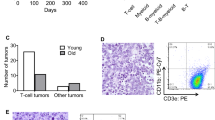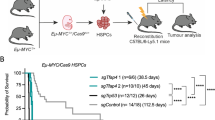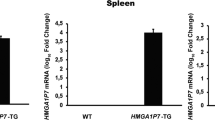Abstract
Deregulation of MYC expression occurs in many haematological malignancies. Previous studies modelling MYC-induced lymphomagenesis in the mouse used transgenic vectors that directed MYC overexpression in a lineage-specific manner. Here, we describe a transgenic mouse strain in which constitutive MYC expression is driven broadly in haemopoiesis by a vector containing regulatory elements of the Vav gene. Healthy young VavP-MYC17 mice had multiple haemopoietic abnormalities, most notably increased size and numbers of B-lymphoid cells, monocytes and megakaryocytes. The mice rapidly developed tumours and, surprisingly, these were exclusively T-cell lymphomas, mostly of mature CD4+ CD8− T cells, a tumour type that is seldom seen in mouse models. To examine tumour development in the absence of the susceptible T cells, we bred VavP-MYC17 mice lacking the Rag1 recombinase. They survived longer and succumbed to tumours of several different haemopoietic cell types: pre-T cells, pro-B cells, macrophages and unusual progenitor cells. Thus, although T-lineage cells have the shortest latent period to transformation, the VavP-MYC17 transgene drives malignant transformation of multiple cell types and VavP-MYC17 mice provide a new model for tumours of multiple haemopoietic lineages.
This is a preview of subscription content, access via your institution
Access options
Subscribe to this journal
Receive 50 print issues and online access
$259.00 per year
only $5.18 per issue
Buy this article
- Purchase on Springer Link
- Instant access to full article PDF
Prices may be subject to local taxes which are calculated during checkout






Similar content being viewed by others
References
Adams JM, Harris AW, Pinkert CA, Corcoran LM, Alexander WS, Cory S, Palmiter RD and Brinster RL . (1985). Nature, 318, 533–538.
Adams JM, Harris AW, Strasser A, Ogilvy S and Cory S . (1999). Oncogene, 18, 5268–5277.
Bath ML . (2003). Biol. Reprod., 68, 19–23.
Boxer LM and Dang CV . (2001). Oncogene, 20, 5595–5610.
Ceredig R and Rolink T . (2002). Nat. Rev. Immunol., 2, 888–897.
Cory S . (1986). Adv. Cancer Res., 47, 189–234.
Egle A, Harris AW, Bouillet P and Cory S . (2004). Proc. Natl. Acad. Sci. USA, 101, 6164–6169.
Eischen CM, Weber JD, Roussel MF, Sherr CJ and Cleveland JL . (1999). Genes Dev., 13, 2658–2669.
Elghetany MT . (1997). Leukemia, 11, 762–764.
Evan G and Littlewood T . (1998). Science, 281, 1317–1321.
Felsher DW and Bishop JM . (1999). Mol. Cell, 4, 199–207.
Grandori C, Cowley SM, James LP and Eisenman RN . (2000). Ann. Rev. Cell Dev. Biol., 16, 653–699.
Hann B and Balmain A . (2001). Curr. Opin. Cell Biol., 13, 778–784.
Hardy RR and Hayakawa K . (2001). Ann. Rev. Immunol., 19, 595–621.
Harris AW, Pinkert CA, Crawford M, Langdon WY, Brinster RL and Adams JM . (1988). J. Exp. Med., 167, 353–371.
Harris NL, Jaffe ES, Stein H, Banks PM, Chan JK, Cleary ML, Delsol G, De Wolf-Peeters C, Falini B and Gatter KC . (1994). Blood, 84, 1361–1392.
Iritani BM and Eisenman RN . (1999). Proc. Natl. Acad. Sci. USA, 96, 13180–13185.
Langdon WY, Harris AW, Cory S and Adams JM . (1986). Cell, 47, 11–18.
Maljaie SH, Brito-Babapulle V, Matutes E, Hiorns LR, De Schouwer PJ and Catovsky D . (1995). Leukemia, 9, 1694–1699.
Marcu KB, Bossone SA and Patel AJ . (1992). Ann. Rev. Biochem., 61, 809–860.
Marsden V and Strasser A . (2003). Ann. Rev. Immunol., 21, 71–105.
Michie AM and Zuniga-Pflucker JC . (2002). Semin. Immunol., 14, 311–323.
Mikkers H and Berns A . (2003). Adv. Cancer Res., 88, 53–99.
Min B, McHugh R, Sempowski GD, Mackall C, Foucras G and Paul WE . (2003). Immunity, 18, 131–140.
Mombaerts P, Clark AR, Rudnicki MA, Iacomini J, Itohara S, Lafaille JJ, Wang L, Ichikawa Y, Jaenisch R, Hooper ML and Tonegawa S . (1992a). Nature, 360, 225–231.
Mombaerts P, Iacomini J, Johnson RS, Herrup K, Tonegawa S and Papaioannou VE . (1992b). Cell, 68, 869–877.
Morse III HC, Anver MR, Fredrickson TN, Haines DC, Harris AW, Harris NL, Jaffe ES, Kogan SC, MacLennan IC, Pattengale PK and Ward JM . (2002). Blood, 100, 246–258.
Nehls M, Pfeifer D, Schorpp M, Hedrich H and Boehm T . (1994). Nature, 372, 103–107.
Ogilvy S, Metcalf D, Gibson L, Bath ML, Harris AW and Adams JM . (1999a). Blood, 94, 1855–1863.
Ogilvy S, Metcalf D, Print CG, Bath ML, Harris AW and Adams JM . (1999b). Proc. Natl. Acad. Sci. USA, 96, 14943–14948.
Pekarsky Y, Hallas C and Croce CM . (2001). JAMA, 286, 2308–2314.
Renno T, Attinger A, Rimoldi D, Hahne M, Tschopp J and MacDonald HR . (1998). Eur. J. Immunol., 28, 540–547.
Sanchez-Beato M, Sanchez-Aguilera A and Piris MA . (2003). Blood, 101, 1220–1235.
Schmitt CA . (2003). Nat. Rev. Cancer, 3, 286–295.
Schmitt CA, McCurrach ME, de Stanchina E, Wallace-Brodeur RR and Lowe SW . (1999). Genes Dev., 13, 2670–2677.
Schmitt CA, Rosenthal CT and Lowe SW . (2000). Nat. Med., 6, 1029–1035.
Shou Y, Martelli ML, Gabrea A, Qi Y, Brents LA, Roschke A, Dewald G, Kirsch IR, Bergsagel PL and Kuehl WM . (2000). Proc. Natl. Acad. Sci. USA, 97, 228–233.
Spanopoulou E, Roman CAJ, Corcoran LM, Schlissel MS, Silver DP, Nemazee D, Nussenzweig MC, Shinton SA, Hardy RA and Baltimore D . (1994). Genes Dev., 8, 1030–1042.
Stewart M, Cameron E, Campbell M, McFarlane R, Toth S, Lang K, Onions D and Neil JC . (1993). Int. J. Cancer, 53, 1023–1030.
Strasser A, Elefanty AG, Harris AW and Cory S . (1996). EMBO J., 15, 3823–3834.
Strasser A, Harris AW, Bath ML and Cory S . (1990). Nature, 348, 331–333.
von Freeden-Jeffry U, Vieira P, Lucian LA, McNeil T, Burdach SEG and Murray R . (1995). J. Exp. Med., 181, 1519–1526.
Acknowledgements
We thank J Adams for helpful discussions, A Strasser for his gift of antibodies, A Wiegmans for technical assistance, C Young for cell sorting, S Mihajlovic for histological processing, and K Birchall and A Naughton for animal husbandry. This work was supported by the National Health and Medical Research Council (NHMRC, Canberra, Program Grant 257502), the US National Cancer Institute (Grant CA43540) and the Leukemia and Lymphoma Society (New York, Specialized Center of Research Grant 7015).
Author information
Authors and Affiliations
Corresponding author
Rights and permissions
About this article
Cite this article
Smith, D., Bath, M., Harris, A. et al. T-cell lymphomas mask slower developing B-lymphoid and myeloid tumours in transgenic mice with broad haemopoietic expression of MYC. Oncogene 24, 3544–3553 (2005). https://doi.org/10.1038/sj.onc.1208399
Received:
Accepted:
Published:
Issue Date:
DOI: https://doi.org/10.1038/sj.onc.1208399
Keywords
This article is cited by
-
MNT suppresses T cell apoptosis via BIM and is critical for T lymphomagenesis
Cell Death & Differentiation (2023)
-
Mnt modulates Myc-driven lymphomagenesis
Cell Death & Differentiation (2017)
-
FoxO3 suppresses Myc-driven lymphomagenesis
Cell Death & Disease (2016)
-
MYC oncogene in myeloid neoplasias
Clinical and Translational Oncology (2013)
-
Differential requirements for c-Myc in chronic hematopoietic hyperplasia and acute hematopoietic malignancies in Pten-null mice
Leukemia (2011)



